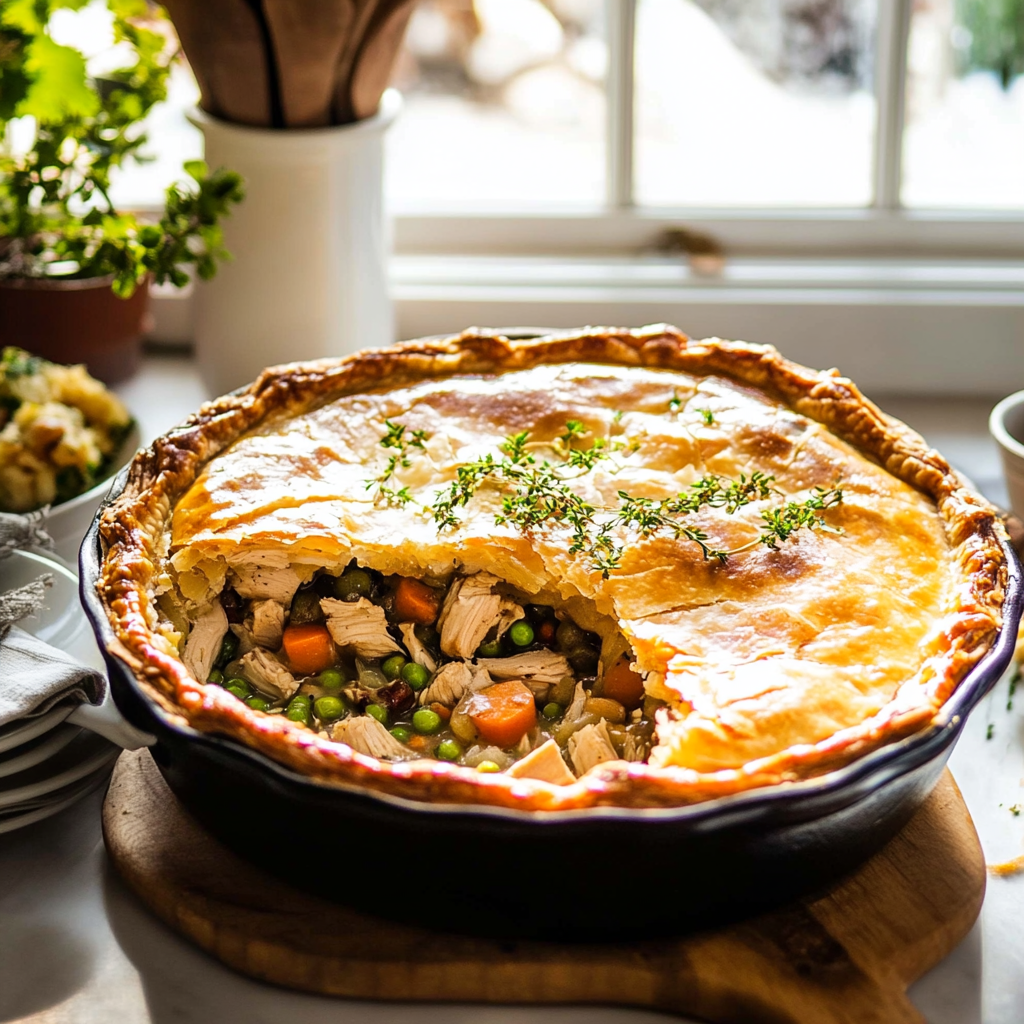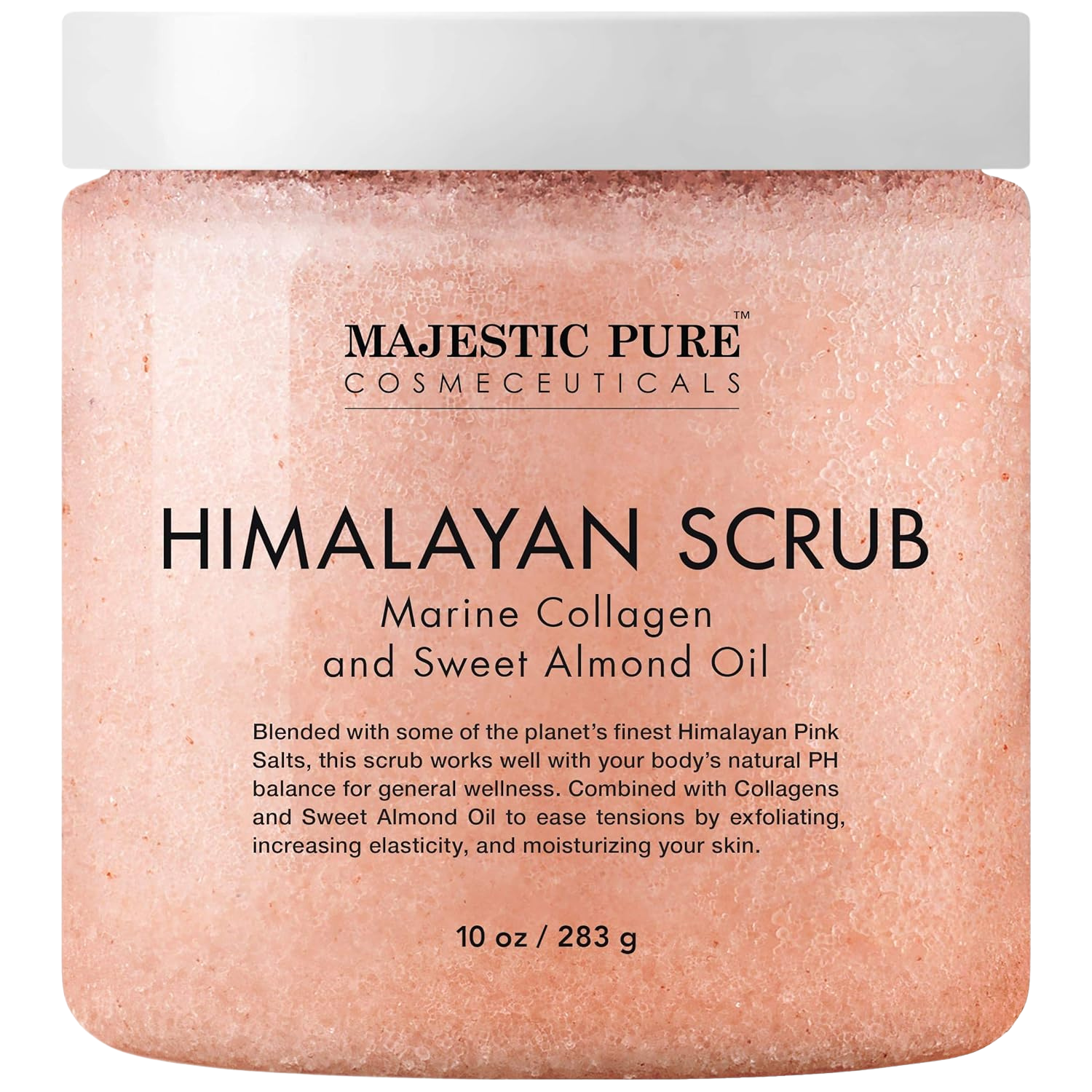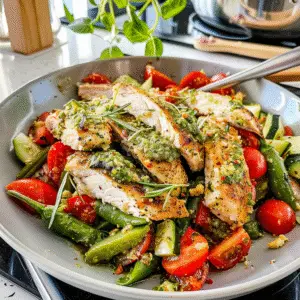Introduction and Quick Summary
Are you looking for a comforting dish that satisfies your cravings without the guilt? Look no further than this healthy chicken pot pie. This recipe combines tender chicken, fresh vegetables, and a creamy sauce all encased in a flaky crust. It’s an ideal dish for family dinners or when you’re simply in the mood for some nostalgic comfort food. Many traditional pot pie recipes can be heavy and high in calories, but this version is designed to be lighter while still providing that rich flavor you love.

Incorporating lean protein and an abundance of vegetables not only enhances the nutritional value but also adds vibrant colors and textures to your plate. The secret lies in using whole-food ingredients to create a delightful filling that doesn’t sacrifice taste for health. As we delve into the preparation details, you’ll discover how easy it is to whip up this wholesome dish right in your kitchen.
Whether you’re serving it on a chilly evening or want something hearty after a long day, this healthy chicken pot pie will surely please everyone at the table. So let’s roll up our sleeves and dive into the main ingredients that will make this meal unforgettable!
Main Ingredients
Chicken Breast
The star of our healthy chicken pot pie is lean chicken breast. You’ll need about 2 cups of cooked and shredded chicken breast for this recipe. This meat is packed with protein while being low in fat compared to other cuts like thighs or wings. Not only does it provide essential nutrients like B vitamins and selenium, but it also serves as a blank canvas that absorbs flavors well. To prepare the chicken, you can either poach it or bake it until fully cooked. Once cooled slightly, shred it into bite-sized pieces for easy mixing with other ingredients.
Vegetables
For the vegetable medley in your pot pie, choose about 2 cups total of mixed veggies such as carrots, peas, celery, and corn. These colorful additions not only enhance the visual appeal but also add important vitamins and minerals. Carrots bring sweetness and crunch while peas offer fiber and protein. Celery adds hydration and crunchiness while corn contributes natural sweetness. Chop all vegetables into small pieces so they cook evenly within the filling. You can use fresh or frozen vegetables based on what’s available; both options work wonderfully.
Whole Wheat Flour
Using whole wheat flour is essential for creating a healthier roux that thickens our sauce without excess calories from white flour. You’ll need about 1/4 cup of whole wheat flour to make a balanced sauce that binds all ingredients together perfectly without compromising flavor or texture. Whole wheat flour adds dietary fiber which aids digestion and keeps you feeling full longer. It also brings a nutty flavor that complements the dish beautifully.
Low-Sodium Chicken Broth
To achieve that creamy consistency without heavy creams or sauces, opt for 3 cups of low-sodium chicken broth as your base liquid. This broth infuses rich flavor into your filling while keeping sodium levels manageable—a crucial aspect of any healthy diet. Homemade or store-bought options work well here; just ensure they are labeled low-sodium to control salt intake effectively.
Greek Yogurt
Finally, replace heavy cream with 1/2 cup of plain Greek yogurt for added creaminess without the extra calories or fat content typically found in traditional recipes. Greek yogurt is rich in protein and probiotics which benefit gut health—an excellent choice for making your filling creamy and delicious while maintaining its healthful qualities.

How to Prepare Healthy Chicken Pot Pie
Step 1: Prepare Your Ingredients
Begin by gathering all necessary ingredients listed above to streamline your cooking process. Start cooking your chicken breast if it’s not already prepared; poach it in simmering water until fully cooked (about 15-20 minutes), then allow it to cool before shredding into bite-sized pieces.
While the chicken cooks, chop your vegetables—carrots should be sliced thinly; celery diced small; peas can be thawed if frozen; corn should be drained if canned or cut off the cob if fresh. Once everything is ready—including measuring out your broth and yogurt—you’ll make a delicious filling that brings all these elements together harmoniously.
Step 2: Create the Filling
In a large skillet over medium heat, add a splash of olive oil then sauté onions (if using) until translucent (about 3-5 minutes). Next add chopped carrots and celery; cook them down until softened (another 5 minutes). Stir in your peas and corn followed by sprinkling in the whole wheat flour—mix everything together well for another minute until evenly coated.
Gradually pour in low-sodium chicken broth while stirring continuously until combined thoroughly without lumps forming—this will help thicken our sauce nicely! Bring mixture to simmering point then stir through shredded cooked chicken along with Greek yogurt until everything’s well incorporated—remove from heat once thickened slightly before proceeding with assembling our pot pie!
Step 3: Assemble & Bake
Preheat your oven to 375°F (190°C). Roll out store-bought or homemade dough onto a floured surface; aim for enough size to cover an average-sized casserole dish entirely without breaking apart when lifting! Transfer filling mixture into casserole dish evenly spreading out before placing rolled dough on top sealing edges carefully by pinching together gently around rim—make several slits across crust’s surface allowing steam to escape during baking process!
Bake uncovered in preheated oven between 30-35 minutes until golden brown on top or bubbling at edges indicating readiness—keep an eye on color adjusting time as needed depending upon individual ovens’ performance! Allow cooling slightly once removed from oven before serving hot alongside favorite sides like salad; enjoy every savory bite!

Serving and Storing Tips
Serving Guidelines
When serving your healthy chicken pot pie, present it hot directly from the oven for maximum warmth and enjoyment! You can serve individual portions directly onto plates or scoop generous servings straight from the casserole dish at family-style gatherings—the choice is yours!
To enhance flavors even further consider garnishing each serving with freshly chopped parsley or thyme leaves adding both color as well as aromatic appeal . Pairing with crisp green salads containing seasonal vegetables makes an excellent accompaniment ensuring balanced nutrition alongside hearty comfort food experience enjoyed by everyone seated at table!
Storing Leftovers
If you find yourself with leftovers after enjoying this delightful meal don’t fret—they store beautifully! Allow any remaining pot pie to cool completely before transferring into airtight containers ensuring freshness lasts longer when refrigerated properly.
Leftover portions can be kept refrigerated safely up-to three days allowing quick reheating options throughout week ahead! Alternatively consider freezing unbaked portions wrapped tightly using aluminum foil along parchment paper preventing moisture loss during freezing allowing convenient future meals ready whenever hunger strikes next time around!
Reheat leftovers by placing into microwave-safe dishes heating incrementally until warmed through thoroughly—or bake frozen versions directly from freezer extending time needed accordingly watching closely till heated entirely inside delicious crusts turn golden brown again—resulting memories created anew making meal time enjoyable each time served!
Mistakes to avoid
When preparing a healthy chicken pot pie, there are several common mistakes that can compromise the dish’s health benefits and flavor. One primary mistake is using pre-packaged pie crusts. While they may save time, these crusts often contain unhealthy trans fats and preservatives. Instead, consider making your own crust with whole grain flour and healthy fats like olive oil or coconut oil for a more nutritious option.
Another mistake is neglecting vegetables. Many recipes skimp on the veggie content, which not only reduces nutritional value but also affects flavor and texture. Aim to include a variety of colorful vegetables such as carrots, peas, and spinach to enhance both the healthiness and taste of your pot pie.
Overcooking the chicken is another frequent issue. Well-cooked chicken is crucial for flavor; however, overcooking can lead to dry meat that detracts from the overall dish. To avoid this, consider poaching or sautéing your chicken just until it’s cooked through, ensuring it remains tender.
Additionally, be cautious about the amount of salt used in your recipe. Many people instinctively add too much salt without tasting first. Instead, use herbs and spices generously to boost flavor without relying solely on salt.
Finally, don’t overlook portion control. Healthy eating doesn’t mean forgoing your favorite foods entirely but rather enjoying them in moderation. Be mindful of serving sizes to maintain a balanced diet while enjoying your delicious healthy chicken pot pie.

Tips and tricks
Creating a delicious healthy chicken pot pie involves some handy tips and tricks that enhance both flavor and nutrition. One key tip is to use lean cuts of chicken breast or thighs instead of fatty cuts. This change significantly reduces saturated fat while keeping the protein content high.
Incorporating whole grains into your crust is another excellent way to boost nutrition. Whole wheat flour contains more fiber than all-purpose flour, helping you feel fuller longer and supporting digestive health.
Experimenting with herbs and spices can elevate the flavor profile of your pot pie without adding unnecessary calories or sodium. Fresh herbs like thyme, rosemary, or parsley can bring out the flavors of your ingredients beautifully.
Consider using low-sodium broth as a base instead of cream-based sauces to keep the dish light yet flavorful. This substitution not only reduces calories but also prevents it from becoming overly heavy.
Make sure you allow time for resting after baking your pot pie before serving it up. This step helps all the layers settle together, making it easier to slice and serve while ensuring that fillings stay intact.
Lastly, involve seasonal vegetables in your recipe whenever possible. Seasonal produce often tastes better and is more affordable than out-of-season options while providing essential nutrients.
Suggestions for Healthy Chicken Pot Pie
When crafting a healthy chicken pot pie, there are several suggestions that can help you achieve optimal taste while maintaining nutritional integrity. First off, consider substituting traditional butter with healthier alternatives like avocado or Greek yogurt in your crust recipe. These alternatives provide beneficial fats without compromising texture or flavor.
You can also add legumes such as chickpeas or lentils into the filling for an extra protein boost while enhancing fiber content—this combination contributes to satiety without overwhelming calorie intake.
Another suggestion is to use cauliflower puree instead of heavy cream for a creamy texture with fewer calories. Simply steam cauliflower until tender, then blend it until smooth before incorporating it into your filling.
If you’re looking for an alternative crust option altogether, using sweet potatoes as a topping adds unique flavor while being gluten-free—a great choice for those with dietary restrictions or preferences.
Don’t forget about color! Using different colored vegetables not only makes your dish visually appealing but also ensures a wider range of nutrients are included in every bite.
Lastly, consider batch cooking your filling ahead of time so you can whip up this healthy chicken pot pie any night of the week quickly! Prepare enough filling at once to freeze portions for later meals—this strategy allows you to have nutritious homemade meals ready when time is tight.

FAQs
What makes this chicken pot pie healthy?
The focus on lean proteins like skinless chicken breast paired with a variety of vegetables makes this healthy chicken pot pie nutritious. Using whole grain flour for the crust boosts fiber content while reducing unhealthy fats by opting for healthier fat sources like olive oil creates a lighter dish overall.
Can I make this dish gluten-free?
Absolutely! To create a gluten-free version of healthy chicken pot pie, use almond flour or gluten-free all-purpose flour in place of regular flour when making the crust. Additionally, ensure that all other ingredients such as broth are certified gluten-free to maintain integrity throughout the dish.
How do I store leftovers?
Leftover healthy chicken pot pie should be stored in an airtight container in the refrigerator where it will last 3-4 days maximum. If you want to extend storage life beyond that period, consider freezing individual portions—this way you can reheat them as needed without sacrificing quality or taste!
Can I use leftover rotisserie chicken?
Using leftover rotisserie chicken is an excellent way to save time when making healthy chicken pot pie! Just remove the skin and shred the meat before adding it into your filling—this quick method adds flavor while keeping preparation easy!
What vegetables work best in this recipe?
While traditional veggies like carrots and peas are popular choices for chicken pot pies, don’t hesitate to experiment with others! Broccoli florets or bell peppers could add unique flavors; asparagus also works well if cut into smaller pieces ensuring everything cooks evenly together!
Is there a dairy-free alternative?
Yes! To create a dairy-free version of healthy chicken pot pie simply substitute any milk-based ingredients like cream with unsweetened plant-based milk alternatives (such as almond milk) blended with nutty bases such as cashew cream instead—both options will keep flavors rich without compromising dietary needs!
Conclusion
In summary, crafting a deliciously healthy chicken pot pie involves avoiding common pitfalls such as using unhealthy pre-packaged products or skimping on vegetable content while embracing nutritious alternatives throughout each step—from choosing lean meats and wholesome grains to experimenting with fresh herbs for enhanced flavors. By following these guidelines combined with our helpful tips and suggestions you’ll be well on your way toward creating satisfying meals that nourish both body and soul! Remember that cooking should be enjoyable; incorporating these methods guarantees you’ll love every bite without guilt attached! Enjoy preparing healthier versions of classic comfort food favorites—you deserve it!




